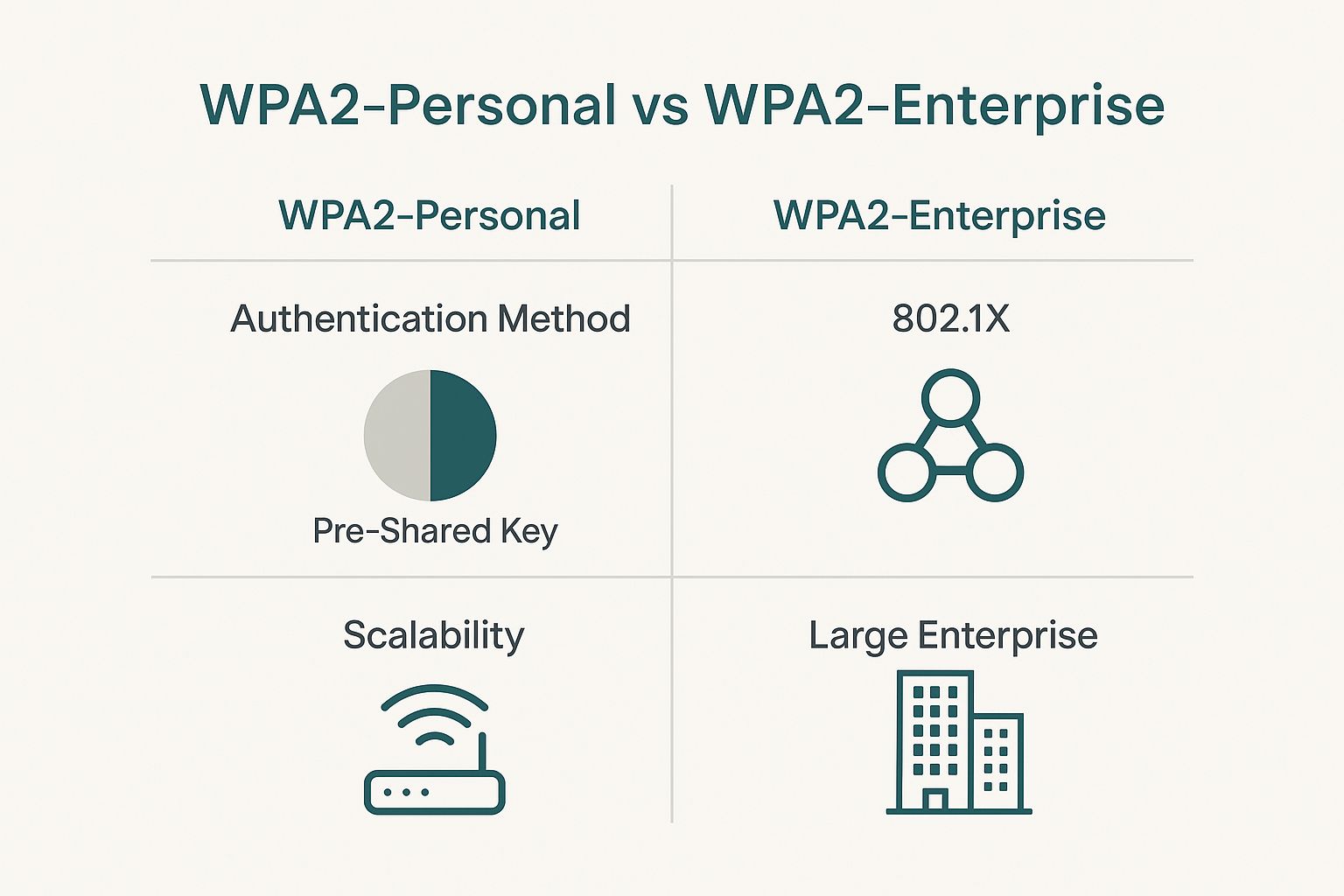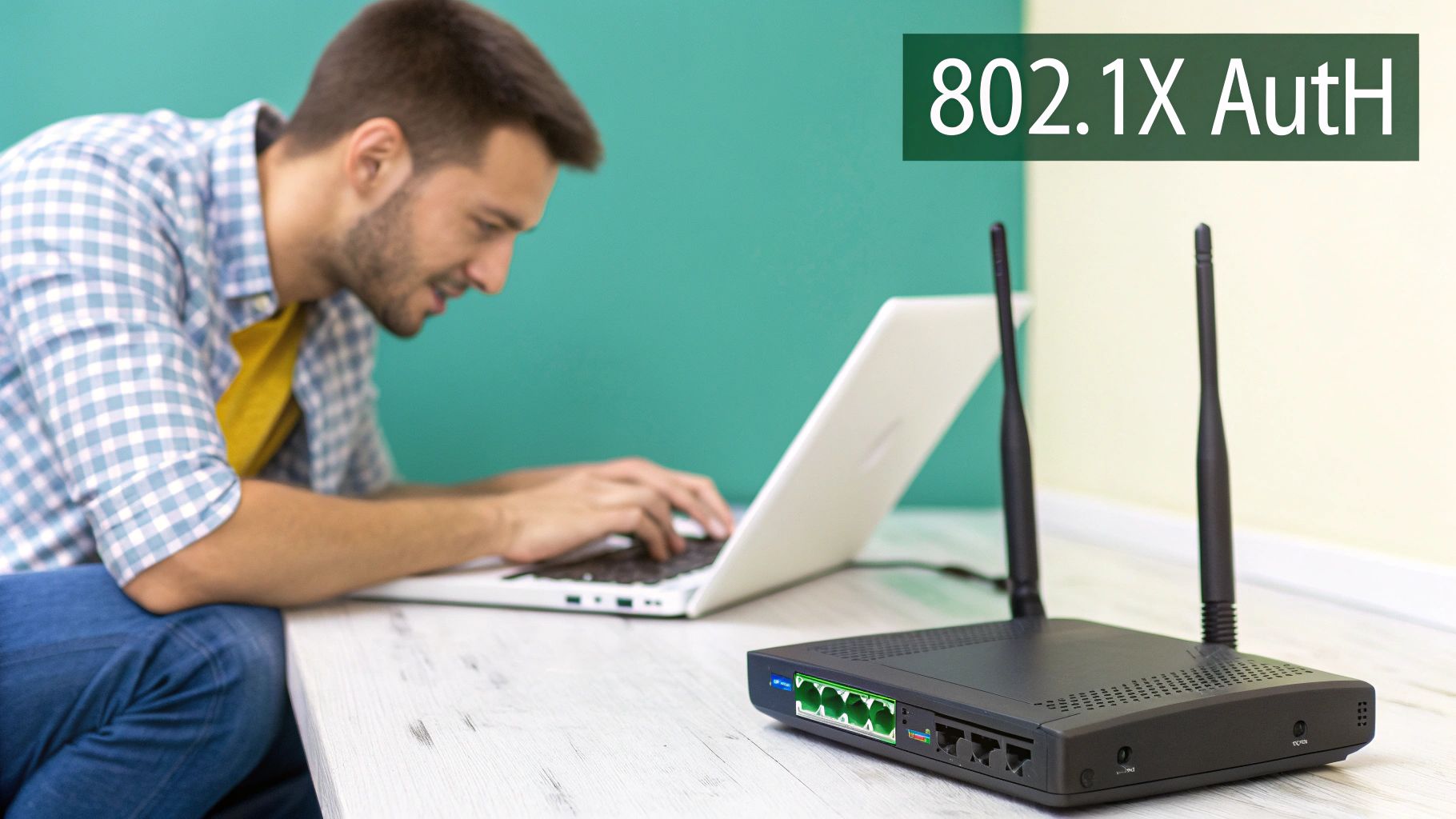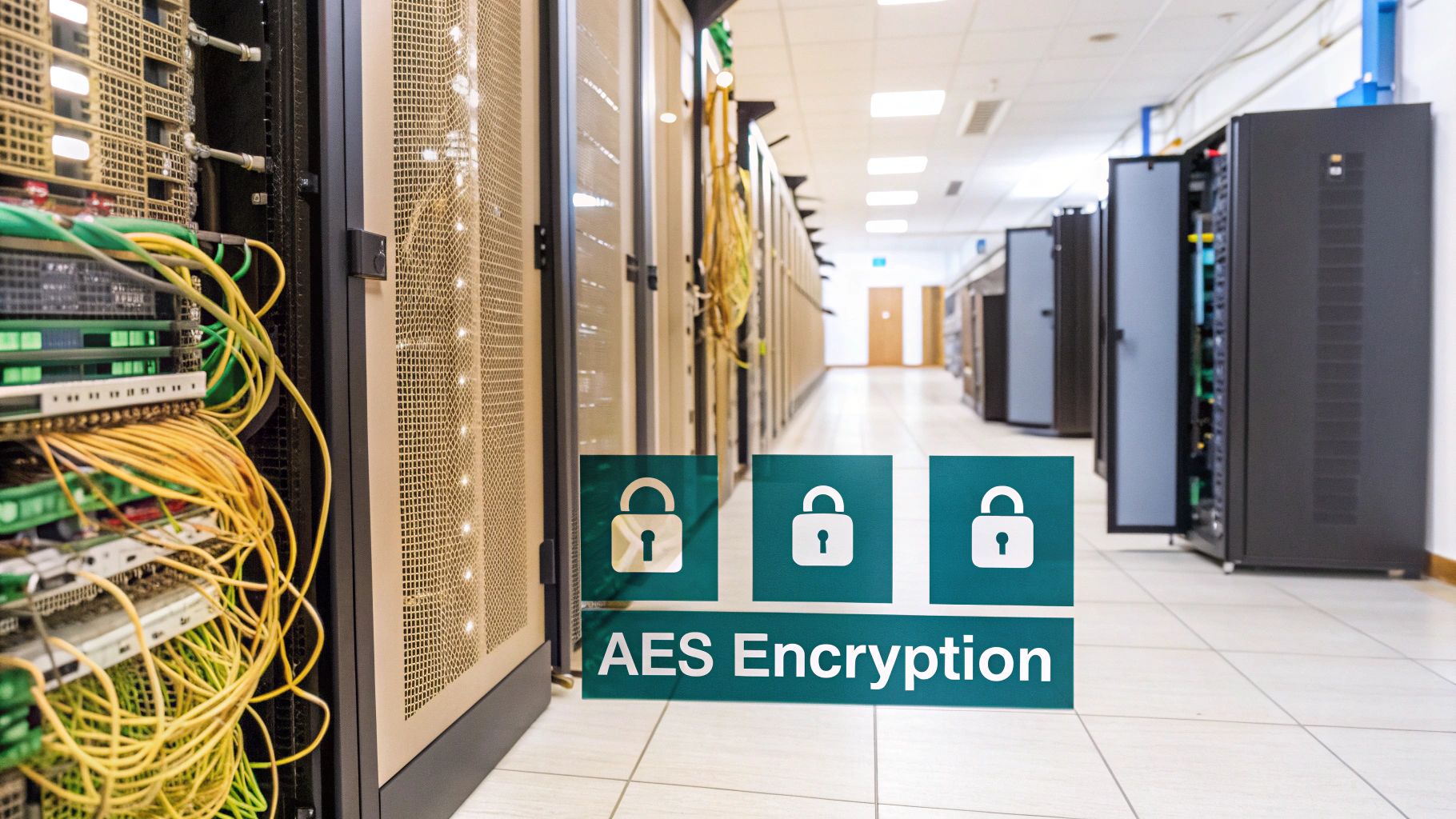Hey there! Picking the right Wi-Fi security often feels more complicated than it needs to be, right? Let's break it down with a simple analogy. Think of WPA2-Personal as a single key to your office door; everyone, from the CEO to the newest intern, uses the same password to get in. WPA2-Enterprise, however, is like giving every single person a unique, personal keycard. It's a game-changer for making your network dramatically more secure and manageable, especially if you're using awesome gear from folks like Cisco or Meraki.
Your Quick Guide to WPA2 Personal vs Enterprise
When you’re weighing WPA2 Personal vs Enterprise, the real decision comes down to how you want to verify who is on your network. WPA2-Personal is straightforward and a solid choice for small teams where simplicity is key.
But for businesses with Bring Your Own Device (BYOD) policies or those operating in sectors like Education and Retail, handling sensitive data is a daily reality. This is where WPA2-Enterprise becomes essential. It provides individual credentials for every user, which gives you amazing control over who can access your network and the power to revoke that access in an instant. This is often managed through a central server or, even better, a cloud dashboard from providers like Cisco Meraki.
This visual highlights the core differences in how each protocol handles authentication and scales with your organization.
As you can see, the simplicity of WPA2-Personal comes at the cost of scalability. WPA2-Enterprise, on the other hand, is built from the ground up to handle the demands of complex, growing environments.
Authentication: The Core Difference
WPA2-Personal and WPA2-Enterprise are designed for fundamentally different environments, largely because of their security approach and ability to scale. You'll find WPA2-Personal, also known as WPA2-PSK (Pre-Shared Key), in most small businesses because it relies on a single, shared password for access. It’s super easy to set up, but that’s where its advantages end.
In contrast, WPA2-Enterprise is built for larger organizations that need more muscle. It uses robust authentication solutions where every single user has their own login, verified by a central server.
WPA2 Personal vs Enterprise At a Glance
To make the choice clearer, here’s a quick side-by-side comparison of the key features. This table should help you quickly pinpoint which protocol aligns with your organization's needs.
| Feature | WPA2-Personal (PSK) | WPA2-Enterprise (802.1X) |
|---|---|---|
| Authentication Method | Single Pre-Shared Key (PSK) | Individual credentials per user (802.1X) |
| Best For | Small offices, homes, small businesses | Medium to large businesses, education, retail |
| Security Level | Moderate; vulnerable if password is shared | High; individual access can be revoked |
| Management | Simple; change password on all devices | Complex; requires a RADIUS server |
| User Experience | Easy; one password for everyone | Seamless; users log in with their own account |
While Enterprise requires more setup, its long-term security and management benefits are undeniable for any serious business network.
The real power of WPA2-Enterprise isn't just about stronger encryption; it’s about individual accountability. When you know exactly who is connected to your network and when, it’s a security game-changer for any growing business.
This is also where modern Wi-Fi management platforms shine. You can build extra layers of security and branding on top of your chosen WPA2 standard. For instance, you could implement a branded login page, known as a Captive Portal, to greet users and control their access. You can learn more about this by reading our guide on what a captive portal is.
The Core Security and Authentication Differences
When you get into the weeds of the WPA2-Personal vs. WPA2-Enterprise debate, you find it's not really about passwords—it's about identity. Both use the same robust AES encryption to keep your data private, but how they handle who gets on your network couldn't be more different. This is the single most important distinction between a simple home network and a truly secure business network.
WPA2-Personal relies on a Pre-Shared Key (PSK). Think of it as one key that unlocks every door in the building. It's simple and easy for a small household. But if that one key gets lost, stolen, or shared with the wrong person, your entire network is exposed. The only solution is to change the password and update it on every single device, which is a massive headache.
Beyond the Shared Password
WPA2-Enterprise does away with this single point of failure. Instead of one password for everyone, it uses a framework called 802.1X to authenticate each connection individually. This is like giving every person a unique, personal ID badge to access the building. Each user gets their own credentials (like a username and password), which are checked against a central authentication server.
This method is a must-have for any BYOD corporate setting. When an employee leaves the company, IT doesn't have to scramble to change the Wi-Fi password for hundreds of people. They just deactivate that one person's credentials. Access is instantly revoked, and nobody else is affected.
The critical difference lies in the authentication approach: WPA2-Personal authenticates devices using a shared key that everyone knows. In contrast, WPA2-Enterprise authenticates each user individually.
This individual authentication is the gold standard for any business needing granular control and a clear audit trail of network activity. It's especially crucial in sectors like Education and Retail, where protecting sensitive student or customer data is a top priority. Thankfully, modern hardware from vendors like Cisco and Meraki has made deploying these advanced authentication solutions much more straightforward than it used to be.
The Rise of Identity-Based Access
This is where the real power of the Enterprise model shines. It lays the groundwork for even more sophisticated security strategies. For instance, if a full 802.1X implementation seems too complex, solutions like IPSK (Identity Pre-Shared Key) or EasyPSK provide a fantastic middle ground. These systems let you issue a unique password for each user or device without needing to manage a full-blown RADIUS server. You can learn more about these powerful options in our guide on security keys for Wi-Fi.
At the end of the day, while both WPA2 versions share the same encryption engine, their authentication models are built for entirely different worlds. WPA2-Personal is for convenience; WPA2-Enterprise is for control, security, and scale—the cornerstones of any serious business network.
Deploying and Managing Your Wi–Fi Network
When it comes to rolling out and maintaining your wireless network, the paths for WPA2-Personal and WPA2-Enterprise diverge significantly. One is built for pure simplicity and speed, while the other is an investment in long-term, scalable, and granular control.
WPA2-Personal is about as straightforward as it gets. You configure a single password on your router or access point, and that's pretty much it. The setup is incredibly fast, and because it doesn’t require any special servers or hardware, it’s the default choice for homes and very small offices.
WPA2-Enterprise, on the other hand, has historically been a much bigger undertaking. The traditional method requires setting up a dedicated RADIUS server to manage individual user credentials, which could be a heavy lift for some organizations. Thankfully, modern authentication solutions have fundamentally changed this dynamic.
The Modern Approach to Enterprise Wi-Fi
Cloud-managed networking platforms, like those from industry leader Cisco Meraki, have streamlined the entire process. Their intuitive, cloud-based dashboards essentially act as your RADIUS server, removing the need for dedicated, on-premise hardware and complex configurations. This innovation puts enterprise-level security within reach for businesses that don't have a large, dedicated IT department.
Once you’re set up on a Meraki network, ongoing management is surprisingly simple. From a single pane of glass, you can:
- Instantly add or revoke network access for individual users.
- See who is on your network and what devices they're using.
- Apply different security rules for different groups of people.
While the initial setup for WPA2-Enterprise demands more foresight, the long-term management payoff is enormous. The power to control access on a user-by-user basis is a world away from the endless, insecure cycle of changing and sharing a single password every time an employee leaves.
This becomes critical in environments with a BYOD corporate policy or in larger deployments across the Education and Retail sectors. Just imagine trying to manage a single password for hundreds of students, staff, or shoppers—it quickly turns into an administrative bottleneck and a major security vulnerability.
This is where integrating with advanced features really makes a difference. For example, IPSK (sometimes called EasyPSK) offers a fantastic middle ground, letting you assign unique keys to each device without the full complexity of a traditional RADIUS deployment. For visitor access, you can use branded Captive Portals to create a polished and secure onboarding experience. If you’d like to learn more about this, you can read our guide on how to set up guest Wi-Fi.
Ultimately, the enterprise model provides a secure foundation that can scale with your organization, delivering a level of control that a single, shared password just can't offer.
Real-World Scenarios for Education, Retail, and Corporate
It's one thing to talk about security protocols in theory, but where the WPA2 Personal vs Enterprise discussion really comes to life is in the real world. Let's look at how different environments choose their path based on day-to-day operations and security demands.
For a small coffee shop's staff-only Wi-Fi, WPA2-Personal makes perfect sense. With only a few employees, a single, shared password gets the job done without any fuss. The moment that environment gets more complex or starts handling sensitive data, though, WPA2-Enterprise becomes essential.
Education and Retail Use Cases
The Education sector is a classic example of where WPA2-Enterprise is non-negotiable. Universities and schools manage thousands of users, and they use Enterprise mode to issue unique login credentials to every student, faculty member, and staffer. This granular control allows IT teams to:
- Assign role-based access to network resources, like letting professors access grading systems while students cannot.
- Instantly revoke access the moment a student graduates or an employee leaves.
- Keep a detailed audit trail of who accessed what and when, which is critical for security and compliance.
In Retail, network segmentation is everything. WPA2-Enterprise is used to isolate critical systems—like point-of-sale (POS) terminals and inventory databases—from the free guest Wi-Fi offered to shoppers. This ensures only authorized corporate devices can touch sensitive data, building a security wall that a shared password simply can't provide. This is a fundamental security practice, often built into hardware from vendors like Cisco and Meraki.
The BYOD Corporate Environment
Perhaps the most compelling modern argument for WPA2-Enterprise is the BYOD corporate world. When employees bring their personal phones, tablets, and laptops into the office, the IT department needs a bulletproof method for securing the network without making life difficult for everyone.
WPA2-Enterprise is the backbone of any serious BYOD policy because it authenticates the user, not just the device. This lets IT apply specific access rules and immediately cut off a device if it's lost or an employee departs—a level of control that's impossible with a single, shared password.
This user-centric authentication is the only truly secure way to manage a modern workplace. It’s the core of robust authentication solutions, especially when you add a Captive Portal for guests or use simplified methods like IPSK or EasyPSK for devices that can’t handle full 802.1X. As cybersecurity threats grow, the adoption of WPA2-Enterprise has climbed steadily across all major industries, a trend you can explore further in research on the WLAN security market.
Layering on Security: Captive Portals and IPSK
Beyond the foundational choice between WPA2-Personal and Enterprise, you can add powerful security layers to your Wi-Fi network. You’ve likely encountered a Captive Portal—it's that branded login page you see at hotels, airports, or coffee shops. We specialize in creating these custom portals, which do more than just look good. They require users to accept terms of service or log in before getting online, adding a crucial layer of accountability.
This approach is perfect for guest networks, but what about those tricky situations where WPA2-Personal isn't secure enough, yet a full Enterprise setup feels like overkill? This is exactly where modern authentication solutions find their sweet spot, offering a practical and secure middle ground.
A Smarter Way to Secure Your Devices
For many organizations, especially in BYOD Corporate or Education settings, managing Wi-Fi for devices that don't support the full 802.1X standard can be a real headache. Think about IoT sensors, network printers, or smart TVs. Using a single shared password for all of them is a significant security risk, but deploying a full Enterprise configuration for these simple devices is often too complex.
This is where Identity Pre-Shared Key (IPSK), a feature championed by vendors like Cisco Meraki, truly shines. It elegantly solves this common problem.
Here’s a glimpse of how you can set up different authentication types right from a Meraki dashboard.
This screenshot highlights the flexibility you get. You can pick the right authentication method for each specific network or use case. IPSK, sometimes called EasyPSK, lets you assign a unique password to each individual user or device without the heavy lifting of managing a full RADIUS server.
Think of IPSK as giving each device its own personal key, instead of a master key for the whole building. This means if one device is compromised or leaves the network, you just revoke its individual key without disrupting anyone else.
This method is incredibly useful for:
- BYOD Corporate environments: Securely onboard employee-owned devices that aren't centrally managed by IT.
- Education campuses: Provide unique keys for student devices in dorms or for school-owned equipment like smartboards and tablets.
- Retail stores: Securely connect critical devices like inventory scanners, point-of-sale systems, and other IoT equipment to the network.
Authentication Methods Feature Comparison
While WPA2-Personal and Enterprise are the most common standards, solutions like IPSK offer a compelling alternative. This table compares how these modern authentication methods stack up for different needs.
| Method | Best For | Security Level | Management Complexity |
|---|---|---|---|
| WPA2-Personal | Home or small office networks with trusted users. | Basic | Very Low |
| IPSK (EasyPSK) | BYOD, IoT, or environments needing simple, per-device security without a RADIUS server. | Medium | Low to Medium |
| WPA2-Enterprise | Corporate, government, or large organizations needing the highest level of security and control. | High | High |
Ultimately, choosing the right security isn't about picking just one tool. By combining a solid security foundation with advanced options like IPSK and captive portals, you can build a network that is both incredibly secure and simple to manage.
To explore these options in more detail, take a look at our guide to wireless access control systems for modern businesses. It’s all about creating layers of security that actually fit your real-world operational needs.
Making the Right Choice for Your Organization
So, how do you actually decide between WPA2 Personal vs Enterprise? The best choice really comes down to a gut check on your organization's security needs, its size, and what you can realistically manage day-to-day.
If you're running a small shop with a handful of trusted employees and aren't handling sensitive data over the air, WPA2-Personal is often the most practical and straightforward solution. It gets the job done without overcomplicating things.
However, the conversation changes the minute your business starts to grow. Once you begin handling customer data, need to meet compliance standards like PCI or HIPAA, or want to properly manage a BYOD corporate policy, the needle points directly to WPA2-Enterprise. The danger of a single shared password getting compromised is just too great. One leak could expose your entire network, and that's a gamble no business should take.
From Basic Security to Strategic Control
This is where WPA2-Enterprise, especially when paired with a modern management platform from vendors like Cisco Meraki, truly shines. It provides the kind of scalable, fine-grained control that today's businesses need. When you add advanced authentication solutions like a custom Captive Portal or IPSK (which you might see called EasyPSK), your Wi-Fi stops being a simple utility and becomes a strategic tool. Suddenly, you have the power to manage access not just for your employees, but for every single device that connects.
It’s no longer just about keeping unauthorized users out. It’s about having deep control over internal access, proving compliance, and delivering secure, reliable Wi-Fi for everyone—from your team in the corporate office to students on a campus or shoppers in a retail store.
Ultimately, you need a network that securely underpins your entire operation. WPA2-Enterprise gives you that solid foundation. For any organization looking to implement this level of security, choosing the right hardware is a critical first step. You can start by exploring different hardware options in our guide to enterprise Wi-Fi access points. This will help make sure your infrastructure can fully support the secure, scalable wireless environment you're trying to build.
Frequently Asked Questions
Still weighing your options between WPA2 Personal and Enterprise? It's a common crossroads for businesses. Let's tackle some of the questions we hear most often as people navigate their Wi-Fi security choices.
Can I Use WPA2 Enterprise For My Guest Wi-Fi?
Technically, yes. But in practice, it’s a logistical nightmare. Imagine having to generate, distribute, and then manage unique credentials for every single visitor who walks through your door. It's just not practical.
A much better approach is to set up a completely separate guest network that uses a Captive Portal. This keeps your internal network completely isolated and secure, gives guests a simple way to connect, and even lets you present your terms and conditions before they get online.
Are All My Devices Compatible With WPA2 Enterprise?
Most modern business-grade devices, like laptops and smartphones, have no problem with WPA2-Enterprise. The potential trouble spot is usually with simpler IoT devices (think smart sensors or older printers) or legacy hardware that just wasn't built for it.
For these devices, an IPSK (Individual Pre-Shared Key) or EasyPSK solution is the perfect fix. Platforms like Cisco Meraki allow you to assign a unique password to each specific device, bypassing the need for full 802.1X compatibility.
Remember, the goal is to secure every connection. Flexible authentication solutions like IPSK ensure you don't have to leave any device behind on an insecure network.
Do I Need A Dedicated IT Expert To Set This Up?
It used to be that setting up WPA2-Enterprise required some serious networking know-how. But that's not the case anymore. Cloud-managed networking systems from vendors like Cisco and Meraki have genuinely changed the game.
Their dashboards are designed to be intuitive, often with a RADIUS server built right in or easily integrated. This makes enterprise-level security far more accessible, even if you don't have a full-time IT specialist on staff. We see this all the time in Education, Retail, and corporate BYOD environments where both strong security and simple management are non-negotiable.
At Splash Access, we work directly with Cisco Meraki to bring these advanced authentication methods to life. We help you build secure, branded, and intelligent Wi-Fi experiences for everyone who connects—from employees and students to customers. Find out how we can help you boost your network security and user engagement by visiting us at https://www.splashaccess.com.







